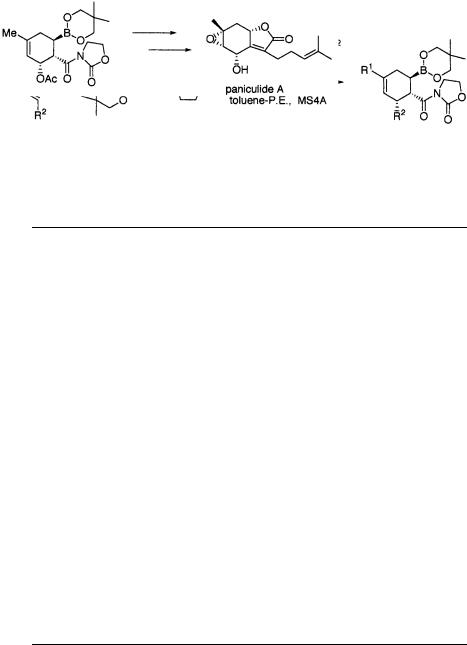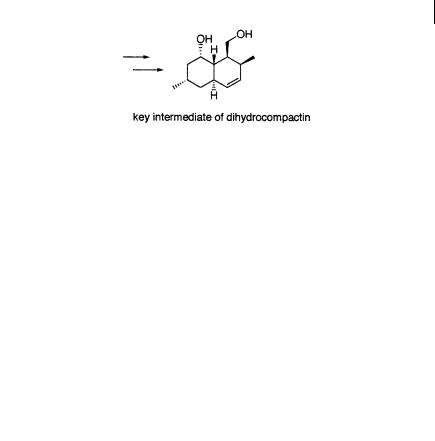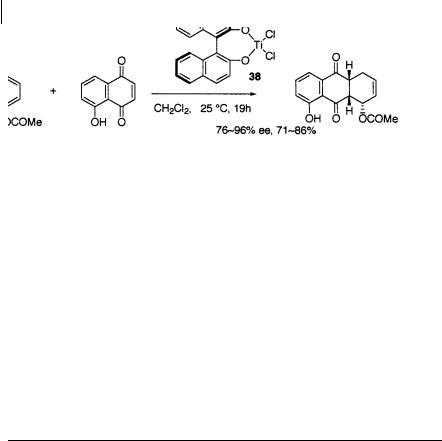
Cycloaddition Reactions in Organic Synthesis
.pdf
37
Table 1.22 Asymmetric Diels-Alder reactions of cyclopentadiene catalyzed by 31 [40 b, 42]
R |
Yield (%) |
endo/exo |
ee (%) |
|
|
|
|
|
|
H |
81 |
>95 : 5 |
88 |
|
Me |
91 |
87 |
: 13 |
94 |
Ph |
76 |
92 |
: 8 |
80 |
Pr |
72 |
91 |
: 9 |
75 |
|
|
|
|
|
Scheme 1.53
Table 1.23 Asymmetric Diels-Alder reactions of a variety of dienes catalyzed by 31 [40 b, 42]
R1 |
R2 |
Yield (%) |
ee (%) |
H |
COOMe |
84 |
91 |
Me |
COOMe |
94 |
94 |
H |
H |
81 |
93 a |
Me |
H |
93 |
>96 a |
SEt |
H |
72 |
91 |
a A mixture of p-xylene-P.E. (11) was used as a solvent
Application of this catalytic process was extended to asymmetric intramolecular Diels-Alder reactions. Synthetically useful intermediates with octalin and decalin skeletons were obtained in high optical purity by use of a catalytic amount of the chiral titanium reagent [45] (Scheme 1.57, Table 1.25). The core part of the mevinic acids was enantioselectively synthesized by use of this asymmetric intramolecular reaction [46] (Scheme 1.58).

38 1 Catalytic Asymmetric Diels-Alder Reactions
Scheme 1.54
Table 1.24 Asymmetric Diels-Alder reactions of 3-borylpropenoic acid derivatives catalyzed by 31 [43]
R1 |
R2 |
Yield (%) |
ee (%) |
|
|
|
|
H |
H |
76 |
>98 |
Me |
H |
74 |
>98 |
Me |
Me |
92 |
94 |
Me |
OAc |
71 |
95 |
|
|
|
|
Scheme 1.55
Scheme 1.56
Table 1.25 Asymmetric intramolecular Diels-Alder reactions catalyzed by 31 [45]
R1 |
R2 |
n |
Time (h) |
Yield (%) |
ee (%) |
H |
H |
1 |
257 |
87 |
87 |
H |
SCH2CH2S |
1 |
68 |
62 |
95 |
H |
SCH2CH2S |
2 |
120 |
64 |
86 |
Me |
SCH2CH2S |
2 |
120 |
70 |
87 |
|
|
|
|
|
|

1.2 The Chiral Lewis Acid-catalyzed Diels-Alder Reaction 39
Scheme 1.57
The titanium catalyst 31 is prepared in-situ by mixing the chiral TADDOL and TiCl2(O-i-Pr)2 in toluene in the presence of MS 4 Å with the generation of isopropyl alcohol (Scheme 1.59). A 1H NMR study showed that formation of the titanium reagent 31 was incomplete, and approximately 16% of the uncomplexed TADDOL remains. The observation of a lower chemical shift for the methine proton of isopropyl alcohol in the mixture, compared with that of isopropyl alcohol itself suggests that the coordination of isopropyl alcohol causes aggregation of the achiral titanium species (TiCl2(O-i-Pr)2) reducing its activity as a Lewis acid [47].
Scheme 1.58
A chiral titanium complex with 3-cinnamoyl-1,3-oxazolidin-2-one was isolated by Jørgensen et al. from a mixture of TiCl2(O-i-Pr)2 with (2R,3R)-2,3-O-isopropyli- dene-1,1,4,4-tetraphenyl-1,2,3,4-butanetetrol, which is an isopropylidene acetal analog of Narasaka’s TADDOL [48]. The structure of this complex was determined by X-ray structure analysis. It has the isopropylidene diol and the cinnamoyloxazolidinone in the equatorial plane, with the two chloride ligands in apical (trans) position as depicted in the structure A. It seems from this structure that a pseudo-ax- ial phenyl group of the chiral ligand seems to block one face of the coordinated cinnamoyloxazolidinone. On the other hand, after an NMR study of the complex in solution, Di Mare et al. and Seebach et al. reported that the above trans dichloro complex A is a major component in the solution but went on to propose another minor complex B, with the two chlorides cis to each other, as the most reactive intermediate in this chiral titanium-catalyzed reaction [41 b, 49]. It has not yet been clearly confirmed whether or not the trans and/or the cis complex are real reactive intermediates (Scheme 1.60).

40 1 Catalytic Asymmetric Diels-Alder Reactions
Scheme 1.59
1.2.3.7 Zirconium
Collins and coworkers applied the bis(tetrahydroindenyl)zirconium triflate 32, which is used as a polymerization catalyst, to the asymmetric Diels-Alder reaction [50] (Scheme 1.61). A remarkable solvent effect was observed – although only a low optical yield was obtained in CH2Cl2, high optical purity (91% ee) was realized in 2-nitropropane by use of only 1 mol% of the catalyst. The catalyst is also effective for crotonoyloxazolidinone, giving the cycloadduct in 90% ee.
Scheme 1.60
1.2.3.8 Lanthanides
Kobayashi et al. have reported the use of a chiral lanthanide(III) catalyst for the DielsAlder reaction [51] (Scheme 1.63, Table 1.26). Catalyst 33 was prepared from binaphthol, lanthanide triflate, and cis-1,2,6-trimethylpiperidine (Scheme 1.62). When the chiral catalyst prepared from ytterbium triflate (Yb(OTf)3) and the lithium or sodium salt of binaphthol was used, less than 10% ee was obtained, so the amine exerts a great effect on the enantioselectivity. After extensive screening of amines, cis-1,2,6-

1.2 The Chiral Lewis Acid-catalyzed Diels-Alder Reaction 41
trimethylpiperidine was found to be the optimum base; when this was used the cycloadduct was obtained in 95% ee. 13C NMR and IR studies showed that the amine additive does not act as a ligand, but rather interacts weakly with a phenolic hydrogen of the binaphthol to form a hydrogen bond. The axial chirality of the binaphthol is thought to be transferred via the hydrogen bonds to the amine part, which shields one side of the dienophile efficiently. Of the lanthanide triflates investigated, Yb(OTf)3 was found to be the most effective catalyst.
Another noteworthy feature of this reaction is that both enantiomers of the DielsAlder adducts can be stereoselectively synthesized by using a single chiral source, (R)-binaphthol, and selection of the appropriate achiral ligand. In the reaction of crotonoyloxazolidinone and cyclopentadiene, the (2S,3R) enantiomer is formed stereoselectively (95% ee) in the presence of chiral catalyst 33. On the other hand, on addition of 3-phenylacetylacetone to catalyst 33 the principle isomer was changed from the (2S,3R) isomer to its (2R,3S) enantiomer, the enantiomeric excess of which was 81%. 3-Phenylacetylacetone, which is a good bidentate ligand for lanthanides, would bind the site where crotonoyloxazolidinone originally coordinated to the chiral catalyst. The crotonoyl imide then has to bind to the other site of the catalyst, where the opposite enantioface would be exposed [51 b, c] (Scheme 1.64).
Scheme 1.61
Nakagawa and coworkers reported a chiral ytterbium catalyst 34 which was prepared from 1,1 -(2,2 -bisacylamino)binaphthalene and Yb(OTf)3 in the presence of diisopropylethylamine by a method similar to that used for Kobayashi’s chiral ytterbium reagent [52] (Scheme 1.65, Table 1.66). The amine also plays an important role in this reaction, because racemic cycloadducts were obtained without the tert-amine. Reduc-

42 1 Catalytic Asymmetric Diels-Alder Reactions
Table 1.26 Asymmetric Diels-Alder reactions of cyclopentadiene catalyzed by 33 [51 b]
R |
Additive |
Temp. ( C) |
Yield (%) |
endo/exo |
(2S,3R)/(2R,3S) |
|
|
|
|
|
|
|
|
Me |
No |
0 |
77 |
89 |
: 11 |
97.5 : 2.5 |
|
Yes |
23 |
83 |
93 |
: 7 |
9.5:90.5 |
n-Pr |
No |
23 |
81 |
80 |
: 20 |
91.5 : 8.5 |
|
Yes |
23 |
81 |
91 |
: 9 |
10:90 |
Ph |
No |
23 |
40 |
81 |
: 19 |
91.5:8.5 |
|
Yes |
23 |
60 |
89 |
: 11 |
10.5:89.5 |
|
|
|
|
|
|
|
Scheme 1.62
ing the amount of catalyst from 25 mol% to 5 or 10 mol% causes a decrease in chemical yield. This catalyst was highly effective in promoting the reaction of crotonoyland acryloyl-oxazolidinones with cyclopentadiene, giving the cyclo adducts in high optical purity.
Scheme 1.63
Shibasaki et al. reported that lithium-containing, multifunctional, heterobimetallic catalysts such as LaLi3tris((R)-6,6 -dibromobinaphthoxide) 35, with moderate Lewis acidity in non-polar solvents, promote the asymmetric Diels-Alder reaction to give cycloadducts in high optical purity (86% ee) [53] (Scheme 1.67). The lithium

1.2 The Chiral Lewis Acid-catalyzed Diels-Alder Reaction 43
Scheme 1.64
Table 1.27 Asymmetric Diels-Alder reactions of cyclopentadiene catalyzed by 34 [52]
R |
Temp. ( ) |
Time (h) |
Yield (%) |
trans/cis |
ee (%) |
|
|
|
|
|
|
H |
0 |
0.33 |
99 |
91 : 9 |
88 |
Me |
0 |
4 |
97 |
91 : 9 |
>98 |
|
|
|
|
|
|
atoms in these heterobimetallic complexes were found to act as a Lewis acid, and the two bromine atoms of the ligand increase the Lewis acidity of the catalyst. Of the lanthanide metals screened, lanthanum gave the best results.
Scheme 1.65
1.2.4
The Asymmetric Diels-Alder Reaction of other Dienophiles
Several highly enantioselective Diels-Alder reactions are known for which the dienophile does not fit any of the above classes. Corey and coworkers applied the chiral aluminum reagent 36 with a C2-symmetric stilbenediamine moiety (videsupra) to the Diels-Alder reaction of maleimides as dienophiles [54] (Scheme 1.68). In most asymmetric Diels-Alder reactions the reactants are usually relatively simple dienes such as cyclopentadiene or monosubstituted butadienes, and unsym-

44 1 Catalytic Asymmetric Diels-Alder Reactions
metrical dienophiles such as acrylic or substituted acrylic derivatives. To achieve enantioselectivity in the Diels-Alder reaction of maleimide, a C2v-symmetric Z-die- nophile, enantioselectivity requires dissymmetry in the diene, and this is the first example of this type of system. The Diels-Alder reaction of 2-methoxy-1,3-buta- diene and N,O-tolylmaleimide in the presence of the chiral aluminum catalyst 36 gave the adduct in 98% yield and 93% ee. ortho Substitution on the N-aryl moiety is indispensable for high enantioselectivity. The coordination of the catalyst at lone pair “a” would be necessary for high enantioselectivity, whereas the bulky aryl group effectively blocks coordination at lone pair “b” (Fig. 1.9). The chiral cycloadduct obtained was elegantly transformed to gracilins B and C [55] (Scheme 1.69).
Scheme 1.66
Fig. 1.9 Lone pairs on maleimide
Scheme 1.67

1.2 The Chiral Lewis Acid-catalyzed Diels-Alder Reaction 45
Wada and coworkers applied TADDOL-TiCl2(O-i-Pr)2 catalyst 37 to the Diels-Alder reaction of (E)-1-phenylsulfonyl-3-alken-2-ones as dienophiles [56] (Scheme 1.70, Table 1.28). The -sulfonyl ketone, which acts as a bidentate ligand for the chiral titanium reagent, reacts with cyclopentadiene to afford the cycloadduct in high optical purity. Because the phenylsulfonyl-methyl group can be transformed by reductive desulfonylation to the methyl group in good yield, this present dienophile can be regarded as an alkenyl methyl ketone equivalent.
Scheme 1.68
Table 1.28 Asymmetric Diels-Alder reactions catalyzed by 37 [56]
R |
X |
Yield (%) |
endo/exo |
ee (%) |
|
|
|
|
|
Me |
Cl |
80 |
>99 : 1 |
>99 |
n-Pr |
Br |
90 |
>99 : 1 |
94 |
Ph |
Br |
65 |
83 : 17 |
78 |
|
|
|
|
|
Mikami and coworkers applied a chiral BINOL (binaphthol)-TiCl2(O-i-Pr)2 complex 38 to the asymmetric Diels-Alder reaction of 5-hydroxynaphthoquinone (juglone) with butadienyl acetate [57] (Scheme 1.71). The crucial finding was that the absence of molecular sieves is essential for high enantioselectivity, whereas their presence is necessary for the formation of the chiral titanium catalyst from BINOL and TiCl2(O-i-Pr)2. In the presence of molecular sieves, however, the DielsAlder cycloadduct was obtained in only 9% ee. The molecular sieves-free BINOL- TiCl2(O-i-Pr)2 complex, which was prepared by centrifugation of the suspension and decanting, gave cycloadducts in high optical purity which are useful chiral building blocks for the synthesis of anthracyclines and tetracyclines. The authors have pointed out that the enantioselectivity is somewhat variable (76–96% ee), and is very sensitive to the activity of the catalyst.
The inverse electron-demand Diels-Alder reaction is also accelerated by Lewis acids, but the successful application of chiral Lewis acids to this kind of Diels-Al- der reaction is very rare. Marko and coworkers applied Kobayashi’s catalyst system (Yb(OTf)3-BINOL-amine) to the Diels-Alder reaction of 3-methoxycarbonyl-2-py- rone with vinyl ether or sulfide [58] (Scheme 1.72, Table 1.29). A bulky ether or

46 1 Catalytic Asymmetric Diels-Alder Reactions
Scheme 1.69
sulfide group is essential for success, with adamantyl vinyl ether and phenyl vinyl sulfide giving adducts in high enantiomeric excess. The chiral cycloadducts obtained are synthetically useful because of their easy transformation to chiral cyclohexadienes upon mild thermolysis.
Scheme 1.70
Table 1.29 Asymmetric inverse electron demand Diels-Alder reactions catalyzed by 39 [58]
R |
Yield (%) |
ee (%) |
|
|
|
O-cyclohexyl |
91 |
82 |
O-adamantyl |
97 |
85 |
SPh |
91 |
>95 |
|
|
|
1.3
The Asymmetric Catalytic Diels-Alder Reaction Catalyzed by Base
In all the reactions described so far a chiral Lewis acid has been employed to promote the Diels-Alder reaction, but recently a completely different methodology for the asymmetric Diels-Alder reaction has been published. MacMillan and coworkers reported that the chiral secondary amine 40 catalyzes the Diels-Alder reaction between a, -unsaturated aldehydes and a variety of dienes [59]. The reaction mechanism is shown in Scheme 1.73. An a, -unsaturated aldehyde reacts with the chiral amine 40 to give an iminium ion that is sufficiently activated to engage a diene reaction partner. Diels-Alder reaction leads to a new iminium ion, which upon hydrolysis af-
